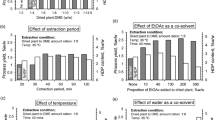Abstract
IN the course of the isolation of aldosterone from adrenal gland extracts (‘Eucortone’, Allen and Hanbury), the English authors detected a compound with properties similar to aldosterone in certain paper and column partition systems. This compound had ultra-violet absorption peaks at about 230 mµ and 280 mµ, and gave a positive reaction with the FeCl3–K3Fe(CN)6reagent. It therefore seemed probable that it was phenolic1. It also gave a blue fluorescence on irradiation with ultra-violet (compound X)2 and reduced blue tetrazolium at about the same rate as steroids having an α-ketol side chain. The compound ran as though slightly more polar than aldosterone in the Bush B5 paper system3 and could be completely separated from the steroid by column chromatography using the same solvent system2.
Similar content being viewed by others
Article PDF
References
Tait, J. F., Ciba Foundation Colloquia on Endocrinology, 7, 201 (1953).
Simpson, S. A., and Tait, J. F., Mem. Soc. Endocrinol., No. 2, 4 (1953).
Bush, I. E., Biochem. J., 50, 370 (1952).
Grundy, H. M., Simpson, S. A., and Tait, J. F., Nature, 169, 759 (1952).
Euw, v. J., Neher, R., Reichstein, T., Tait, J. F., Tait, S. A. S. and Wettstein, A. (Helv. Chim, Acta in the press).
Author information
Authors and Affiliations
Rights and permissions
About this article
Cite this article
VON Euw, J., REICHSTEIN, T., NEHER, R. et al. 3,4,ω-Trihydroxyacetophenone 3-methyl Ether in Adrenal Extracts. Nature 184, 268 (1959). https://doi.org/10.1038/184268b0
Issue Date:
DOI: https://doi.org/10.1038/184268b0
Comments
By submitting a comment you agree to abide by our Terms and Community Guidelines. If you find something abusive or that does not comply with our terms or guidelines please flag it as inappropriate.



